Published: 23 October 2020
Childlessness has become more common among men in urban areas and women in rural areas
Corrected 29 October 2020: The headings and row headings of Appendix tables 2, 3, 4 and 5 have been corrected. The corrections are indicated in red.
According to Statistics Finland's statistics on the population structure, childlessness among persons aged 40 to 44 has increased during 2000 to 2019 especially for men living in urban areas and for women living in rural areas. For men in rural areas, the development of childlessness has partly been the opposite in the 2010s.
Share of childless persons aged 40 to 44 by sex, per cent
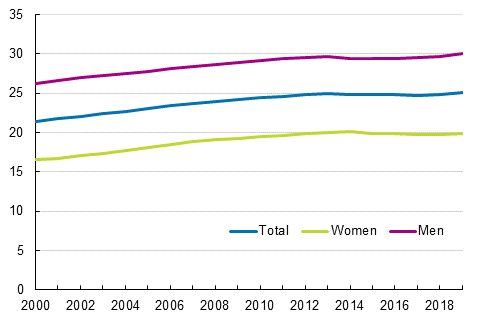
At the end of 2019, a total of 87,045 persons aged 40 to 44 were childless. The figure is 25 per cent of the whole age group. Childlessness among persons aged 40 to 44 has become more common since 2000, when its share was still under 22 per cent. Both women's and men's childlessness has become more common during the review period. In 2019, as many as 30 per cent of men aged 40 to 44 and 20 per cent of women were childless.
Nearly one third of men aged 40 to 44 living in urban areas are without children
The urban-rural classification maintained by the Finnish Environment Institute and the Department of Geography of the University of Oulu enables regional examination of the population irrespective of administrative boundaries. Here the area categories are combined with rural areas (local centres in rural areas, rural areas close to urban areas, rural heartland areas, sparsely populated rural areas) and urban areas (inner urban area, outer urban area, peri-urban area).
Share of childless persons aged 40 to 44 by type of family status and sex in 2000 to 2019, per cent
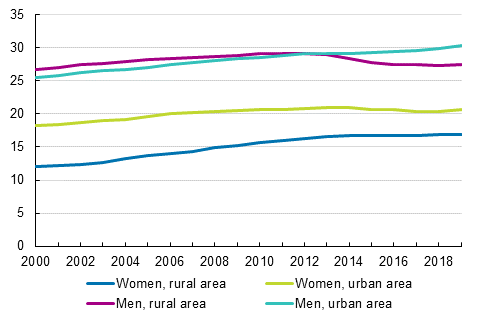
Childlessness is less common in rural areas than in urban areas. Twenty-two per cent of those aged 40 to 44 in rural areas were without children in 2019, while the corresponding share was 26 per cent in urban areas. The regional difference is similar for men and women, although the difference in childlessness between rural areas and urban areas is larger for women. Altogether 28 per cent of men aged 40 to 44 living in rural areas and as many as 30 per cent of men in urban areas were childless. Correspondingly, 17 per cent of women in rural areas aged 40 to 44 and 21 per cent of women in urban areas had no children.
During 2000 to 2019, the share of childless people in the 40 to 44 age group has grown most among women in rural areas and among men in urban areas (in both by 4.8 percentage points). Childlessness has changed least for men in rural areas, where the share of childless men has even diminished from 29.2 per cent in 2010 to 27.5 per cent in 2019.
Childlessness became more common among married and cohabiting couples
Share of childless persons aged 40 to 44 by type of family status and sex in 2000 to 2019, per cent
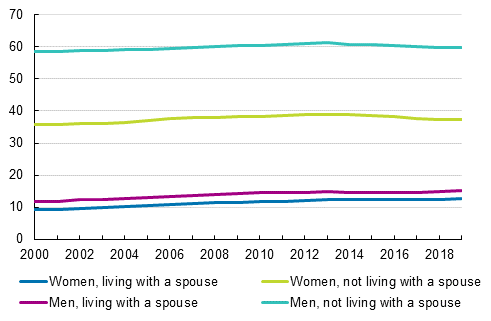
For married and cohabiting couples, childlessness has increased steadily over two decades. Of men aged 40 to 44 living with a spouse, 12 per cent were childless in 2000. The share has risen to 15 per cent by the end of 2019. The share has also gone up from 9 to 13 per cent among married or cohabiting women aged 40 to 44 over the same period.
The share of childless persons has remained more even among those who were not married or cohabiting in the review year. In 2019, the share of childless women aged 40 to 44 not living with a spouse was 37 per cent and that of childless men aged 40 to 44 was 60 per cent. The share of women without children has risen by 1.5 percentage points and that of men by just good one percentage point between 2000 and 2019.
As many as 1.6 million persons with no religious affiliation
A total of 1.6 million persons did not belong to any religious community in 2019. Twenty-four per cent of those speaking Finnish as their mother tongue and 19 per cent of those with Swedish as their mother tongue had no religious affiliation. Of foreign-language speakers, 85 per cent are not members of any religious community registered in Finland. The information on religious community does not represent accurately immigrants, in particular. Not all religious communities are included in the register of the National Board of Patents and Registration and not all those practising a religion belong to a religious community.
Number of persons with no religious affiliation by language in 2000 to 2019
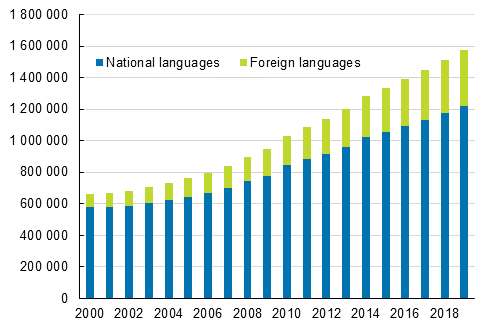
Because the information on belonging to a religious community gives a deficient picture of the situation of immigrants, for example, it is advisable to examine the change by language group as well. The share of persons with no religious affiliation among foreign-language speakers has remained almost on the same level in the 2000s, growing by just three percentage points in that period. For the Finnish-speaking population the share has grown from 12 per cent in 2000 to 24 per cent. The share of persons with no religious affiliation among Swedish speakers grew from 8 to 19 per cent.
Of men speaking national languages, 28 per cent did not belong to a religious group, while 20 per cent of women had no religious affiliation. For those speaking other languages, there was a slightly smaller difference between women and men, 83 per cent of women and 87 per cent of men had no religious affiliation.
Growing number of persons with no religious affiliation both in urban and rural areas
The share of persons with no religious affiliation has grown in both urban and rural areas in the 2000s. The growth has been faster than average in inner urban areas, 19 percentage points. In 2019, altogether 37 per cent of the population lived in these densely built compact areas of towns. In the 2000s, the change was smallest in sparsely populated rural areas and in rural heartland areas, where the share of those with no religious affiliation grew by 10 percentage points.
Persons speaking national languages with no religious affiliation according to the urban-rural classification 2000–2019, per cent
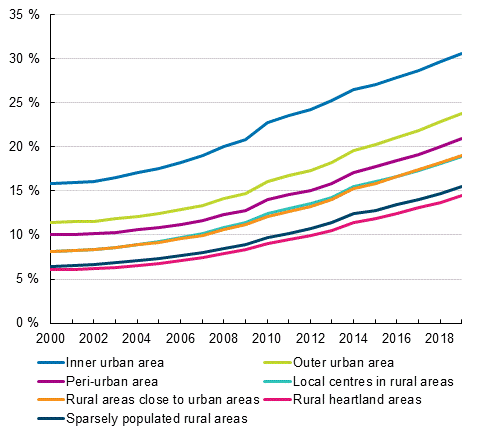
Among persons speaking national languages the shares of those with no religious affiliation have also risen in each area type of the urban and rural classification. The growth was steepest in urban areas, as from 2000 the share of persons with no religious affiliation rose from 14 to 27 per cent in urban areas. Over the same period, the rise in rural areas was from 7 to 17 per cent. In inner urban areas the rise was also steepest for national language speakers, 15 percentage points. Both in rural heartland areas and sparsely populated rural areas the growth amounted to under 10 percentage points.
Number of people with dual citizenship 135,300 in 2019
There were some 135,272 persons who held the citizenship of some other country in addition to Finnish citizenship in 2019. The number of these so-called dual citizens has grown by 62 per cent since 2009. The number of persons with dual citizenship was highest in Uusimaa, 53 per cent of all persons with dual citizenship. The number of dual citizens was next highest in Southwest Finland (9%) and Pirkanmaa (7%). The majority of persons with dual citizenship, or 86 per cent, were living in urban areas according to the urban-rural classification.
Number of persons with dual citizenship by age and sex in 2019
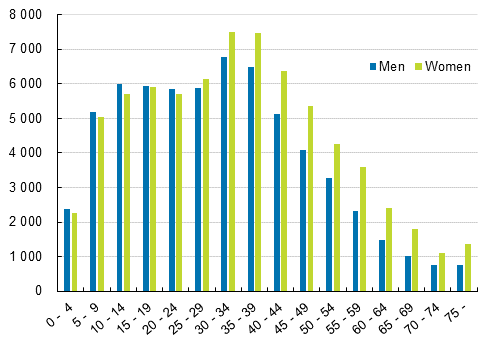
More of the dual citizens are women, 53 per cent. Men with dual citizenship are younger than women. Of the persons aged under 25, there are more men with dual citizenship than women, but in the 25-year-old and older age groups the situation is the opposite.
Clearly the most common second citizenship for dual citizens is Russia, whose citizens numbered over 33,000 in 2019. The next three largest groups are dual citizens of Sweden, Somalia and Estonia. After 2015, former Serbia and Montenegro has fallen from the 15 largest dual-citizenship groups, and been replaced by Ukraine, of whose citizens over 2,000 were Finnish citizens in 2019. There is variation in the gender distribution of nationality groups. At least 60 per cent of the dual citizens of Russia, Thailand, Ukraine and China are women. Iraq, Turkey and the United Kingdom are more male-dominated countries of dual citizenship among Finnish citizens, of which over 55 per cent are men.
Finnish citizens with dual citizenship in 2019, top 15 countries
| Second nationality | Males, % | Females, % | Total |
| Russia | 35,5 | 64,5 | 33 455 |
| Sweden | 51,1 | 48,9 | 8 494 |
| Somalia | 50,7 | 49,3 | 6 977 |
| Estonia | 41,8 | 58,2 | 6 440 |
| Iraq | 59,1 | 40,9 | 5 349 |
| Iran | 52,7 | 47,3 | 4 298 |
| United States | 49,2 | 50,8 | 4 265 |
| Vietnam | 43,6 | 56,4 | 3 824 |
| Turkey | 65,4 | 34,6 | 3 766 |
| Afghanistan | 52,2 | 47,8 | 3 581 |
| Thailand | 35,5 | 64,5 | 2 809 |
| United Kingdom | 56,4 | 43,6 | 2 494 |
| Germany | 51,7 | 48,3 | 2 451 |
| Ukraine | 40,4 | 59,6 | 2 056 |
| China | 29,9 | 70,1 | 1 690 |
Of the dual citizens 76 per cent, approximately 103,100 persons, were of foreign background. Persons whose both or the only known parent were born abroad are considered to be of foreign background. The share of persons with foreign background born abroad among dual citizens was 63 per cent. The countries of birth of dual citizens with Finnish background were almost evenly both Finland and foreign countries.
Share of persons from lower development countries has grown among persons with foreign background
Here we examine the background countries of persons with foreign background born abroad according to the Human Development Index (HDI). Some countries, such as Somalia, have not been given a figure in the 2018 index. Here, people with Somali background have been combined with the low development group. The selection is based on Somalia’s HDI for 2012. The background country refers to the country of birth of the mother or father, or if it is not known, the person's own country of birth.
Number of persons with foreign background born abroad by the background country’s HDI in 2000 to 2019
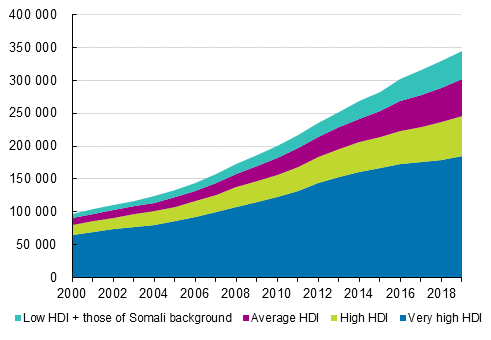
In 2019, the majority of persons with foreign background born abroad came from very high development countries (184,300 persons) or from high development countries (60,900 persons). There were 57,300 persons with foreign background born abroad whose background country is an average development country. In all, 42,700 persons with foreign background came from a background country with low HDI.
Over the past two decades, the number of persons with foreign background belonging to the background country groups of average and low development has grown five-fold, from 16,600 persons in 2000 to 99,900 persons in 2019. Over the same period, the number of persons from a country with a high or very high index has doubled from 79,800 to 165,400 persons.
Persons with foreign background born abroad by the background country’s HDI, per cent
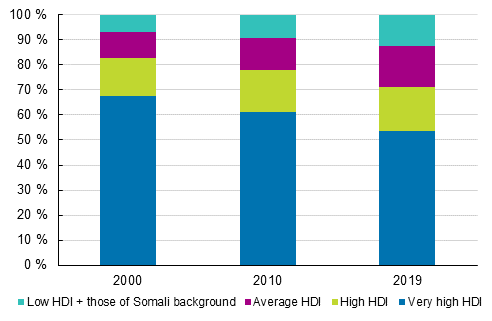
The background country structure of persons with foreign background has changed steadily over the past two decades, but the background country groups with high or very high development were still largest in 2019. In 2000 to 2019, the share of the low HDI background country group among all persons with foreign background born abroad has grown from 7 to 12 per cent. Correspondingly, the share of background countries with average development has risen from 10 to 17 per cent and that of the high index group from 15 to 18 per cent. The share of people from countries with very high development has fallen from 68 to 53 per cent between 2000 and 2019.
Source: Population Structure 2019, Statistics Finland
Inquiries: Laura Lipasti 029 551 3041, Juhana Nordberg 029 551 3051, info@stat.fi
Head of Department in charge: Hannele Orjala
Publication in pdf-format (419.1 kB)
- Tables
-
Tables in databases
Pick the data you need into tables, view the data as graphs, or download the data for your use.
Appendix tables
- Appendix table 1. Married women by duration and order of marriage 31.12.2019 (23.10.2020)
- Appendix table 2. Females aged 15 - 84 by number of live-born children 31.12.2019 (Table was corrected on 29 October 2020. The corrections are indicated in red.) (23.10.2020)
- Appendix table 3. Males aged 15 - 84 by number of live-born children 31.12.2019 (Table was corrected on 29 October 2020. The corrections are indicated in red.) (23.10.2020)
- Appendix table 4. Women by age, number of children and the proportion of birth 31.12.2019 (Table was corrected on 29 October 2020. The corrections are indicated in red.) (23.10.2020)
- Appendix table 5. Males by age and number of children 31.12.2019 (Table was corrected on 29 October 2020. The corrections are indicated in red.) (23.10.2020)
- Figures
- Quality descriptions
-
- Quality description: Population structure 2019 (23.10.2020)
Updated 23.10.2020
Official Statistics of Finland (OSF):
Population structure [e-publication].
ISSN=1797-5395. annual review 2019. Helsinki: Statistics Finland [referred: 18.4.2024].
Access method: http://www.stat.fi/til/vaerak/2019/01/vaerak_2019_01_2020-10-23_tie_001_en.html

